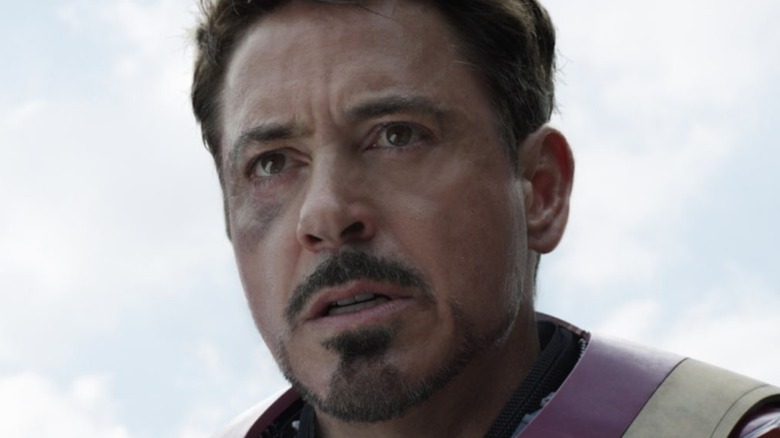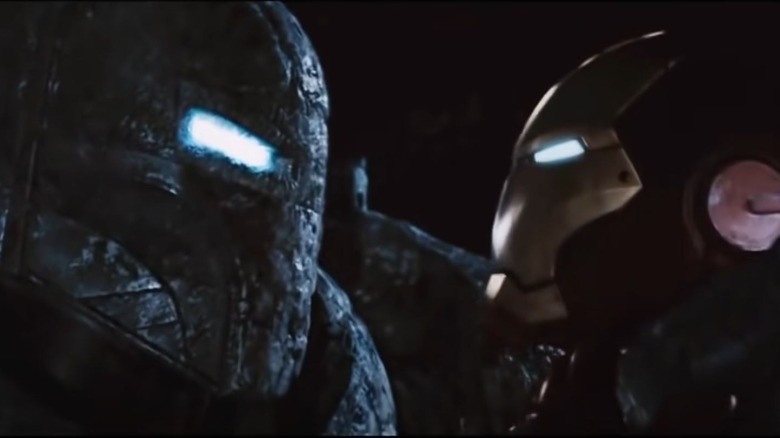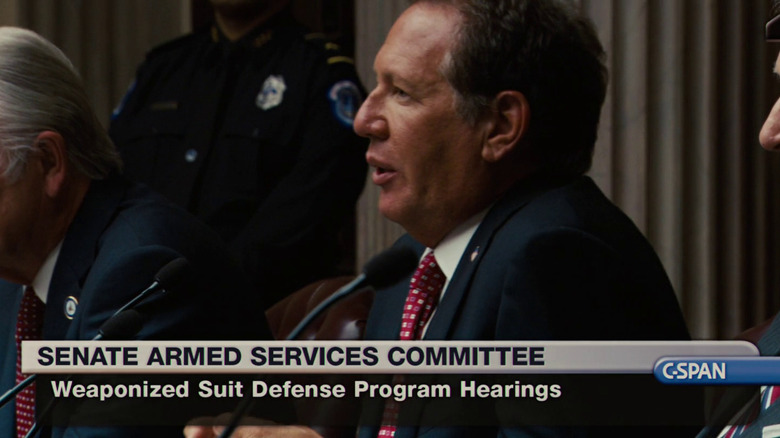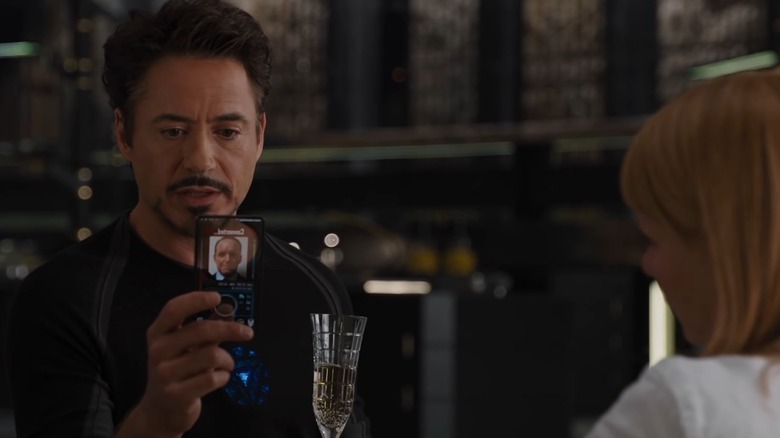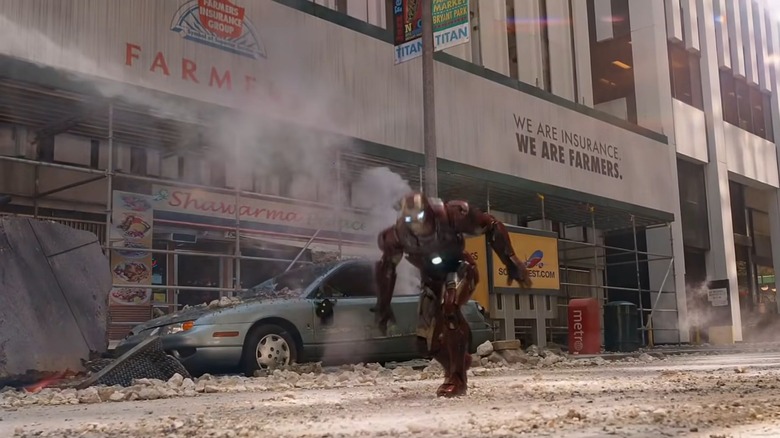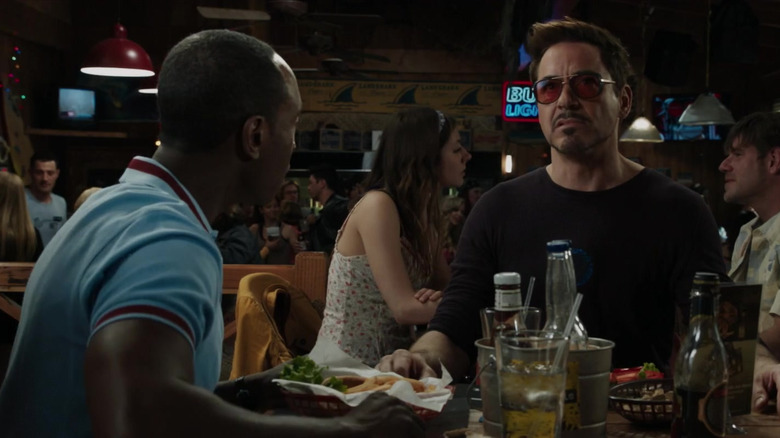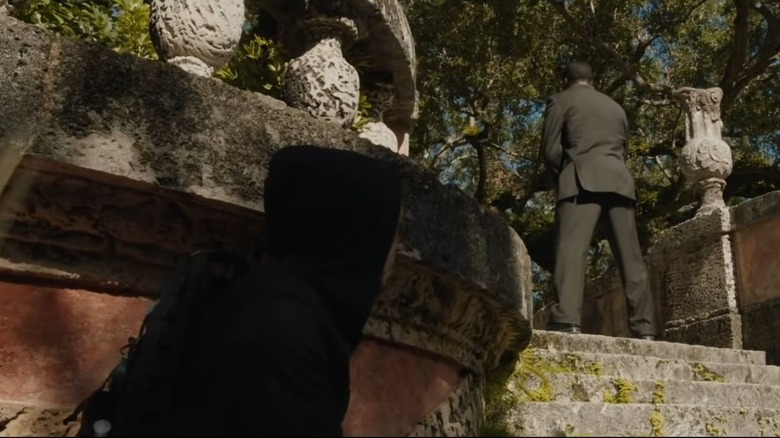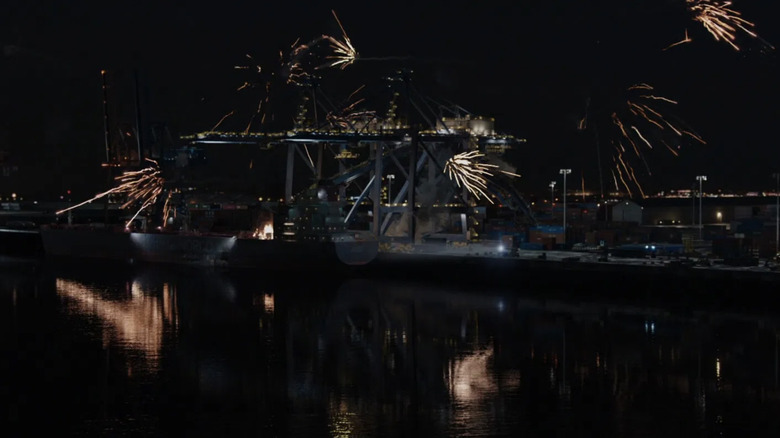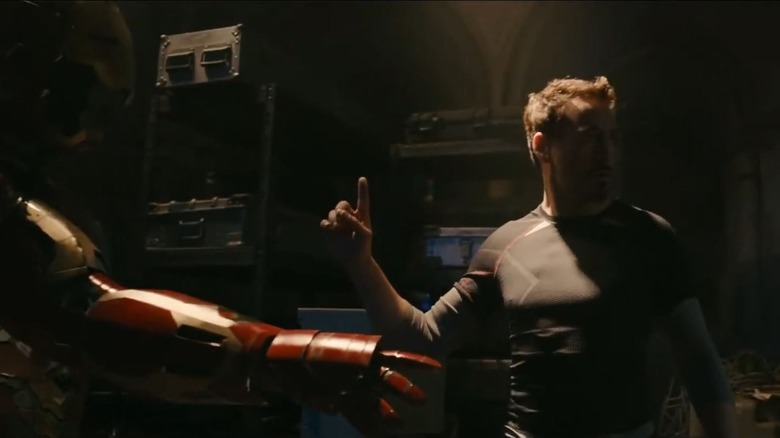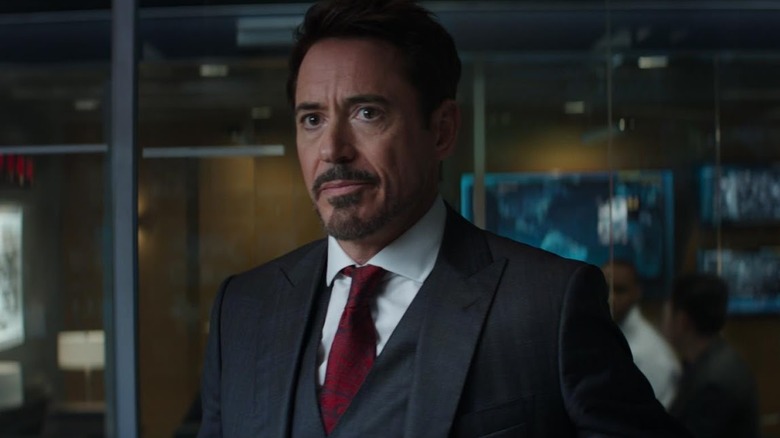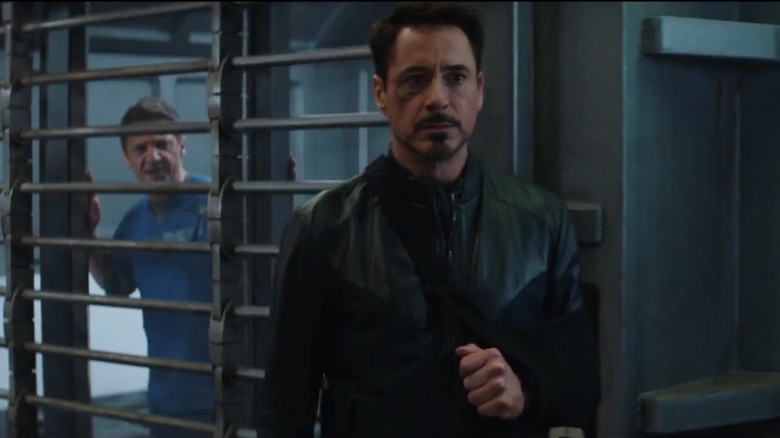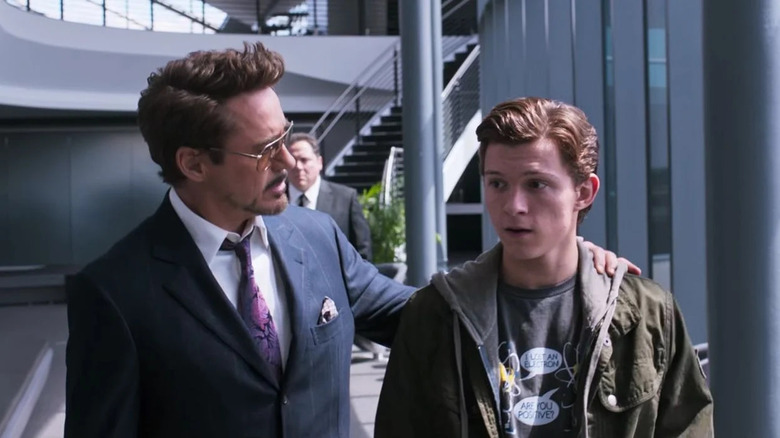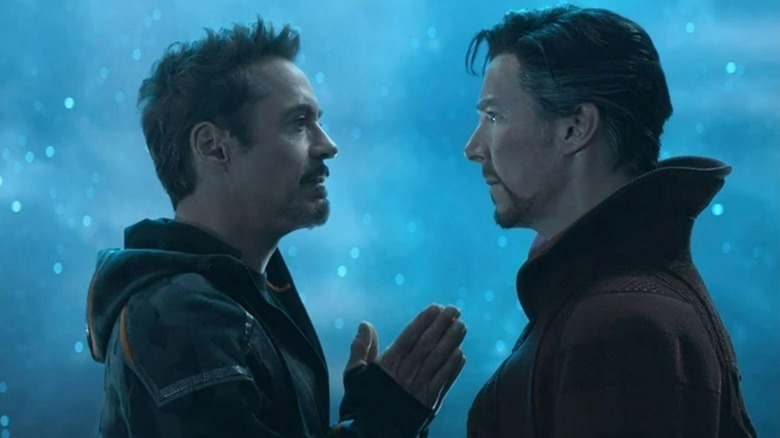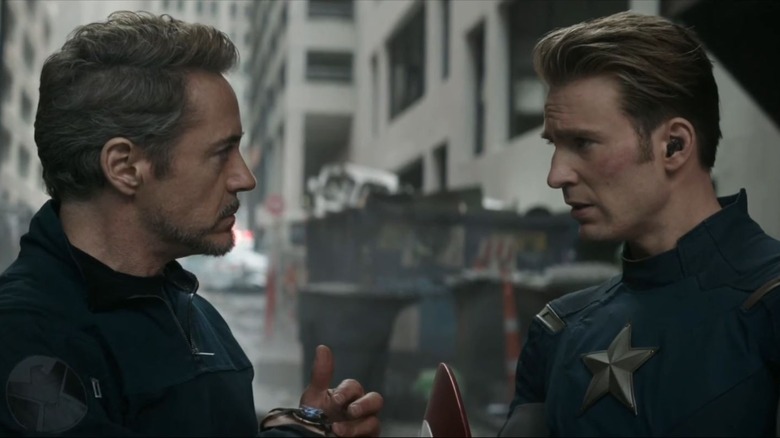Iron Man's Most Underrated Moments
From his first appearance in 2008's "Iron Man" to his final departure in 2019's "Avengers: Endgame," Robert Downey Jr.'s Tony Stark has been the face of the Marvel Cinematic Universe, the most successful movie franchise to ever exist. With that near-universal popularity comes a variety of fan favorite quotes, scenes, and action pieces, but when there is so much to love, it's only natural that some great moments will fall through the cracks over the course of 11 years and nine film appearances (cameos not included).
In between the thrilling suit-up scenes and the emotionally devastating character drama are a thousand moments that get overshadowed by the larger narrative and its mind-blowing spectacle. Whether it's a throw-away line that's especially insightful or a fun twist that just doesn't seem to be talked about nearly enough, the items on this list all highlight aspects of Tony Stark that fans have come to love but may have missed or underappreciated the first time through.
'How'd you solve the icing problem?'
It's the final battle between Tony Stark, the Iron Man, and Obadiah Stane (Jeff Bridges), the Iron Monger. Stane's suit is larger and seemingly more powerful, but when the combatants take to the skies, it becomes clear that Stark has thought of something that Obadiah didn't: the "icing problem."
Earlier in 2008's "Iron Man," Stark tests out the flight systems of the Mk. II suit for the first time and discovers that flying too high causes the armor to freeze over and shut down. He promptly fixes this for the Mk. III and uses that to his advantage against Iron Monger, but this moment is indicative of one of the most incredible through-lines in the entire MCU.
The Iron Man armor doesn't just change over time: Tony Stark adapts it from movie to movie based on the specific events of the previous film. In "Iron Man 2," his suit struggles against Vanko's (Mickey Rourke) electrical whips, but by "Avengers," his armor can absorb excess electricity like it does when hit by Thor's lightning. In "Infinity War," Stark's incredible nanotech armor is destroyed by Thanos because, in part, the collapse of the suit's physical shields uses up the armor's limited store of nanoparticles. By "Endgame," however, Tony has implemented hard-light-style energy shields to keep that from happening again.
Seeing Tony's armor adapt to the specific challenges within each film's narrative created an incredibly satisfying technological evolutionary process, and that all started here.
Senator Stern presents Tony Stark with a medal of service
At the end of 2008's "Iron Man," Tony tells the world that he's the pilot and inventor of the revolutionary new "Iron Man" armor, and by the time its sequel rolls around in 2010, financial and political powers the world over want that tech for themselves. To that end, United States Senator Stern of Pennsylvania (Garry Shandling) leads hearings in which the man tries to force Stark to hand over the armor to the federal government. He refuses, and the film frequently cuts back to Stern's commentary on Tony's self-destructive spiral throughout the story.
By the end, however, after Iron Man and War Machine (Don Cheadle) defeat Whiplash and save the day, the US decides to award the pair medals for their service. Tony asks SHIELD Director Nick Fury (Samuel L. Jackson) to force Senator Stern to eat his words, present the awards himself and personally congratulate each of them. It's a great scene that's made even richer after watching "Captain America: The Winter Soldier" and realizing that Stern was a corrupt member of Hydra all along.
Tony pretends to be a Life Model Decoy
Towards the beginning of the 2012 hit film, "The Avengers," SHIELD Agent Phil Coulson, played by Clark Gregg, heads to Stark Tower in New York City to deliver a briefing on Loki and the Tesseract to the eccentric billionaire. On his way to the building, Coulson attempts to call Stark several times, and when Stark finally picks up the phone, he attempts to get rid of the man by saying, "You have reached the Life Model Decoy of Tony Stark. Please leave a message."
Many moviegoers likely missed the reference or didn't think anything of it as the dialogue is a throwaway line that's difficult to hear, but it's an incredibly clever and surprisingly subtle reference to one of Marvel Comics' more obscure concepts. A classic, long-running tool of SHIELD, Life Model Decoys are life-like androids that can perfectly mimic the physical skills, voice, body language, and movement of human beings. They're typically used to obfuscate the location and actions of the organization's agents; Nick Fury uses them so often that any appearance he makes on the page is very unlikely to actually be the man himself.
Iron Man spots the shawarma joint during the final battle
2012's "The Avengers" has one of the most fondly remembered after-credits scenes of the entire Marvel Cinematic Universe. After delivering a nuclear missile through a portal and being caught and revived by the Hulk, Tony asks the team if they want to go to a restaurant that serves shawarma, a popular meat-based dish from various regions of the Middle East. After the credits roll, audiences are treated to the Avengers eating at that very restaurant.
Not only is it an unexpected payoff to a seemingly throwaway line, but it's a great scene. The team is absolutely exhausted after a horrific battle against a seemingly unstoppable alien force that almost killed nearly every member of the team at least once, and they sit in stunned silence as they simply... eat.
What many fans may not realize, however, is that the post-credits scene was set up even earlier in the film when Tony spots the exact restaurant during the Battle of New York. After flying inside of a Chitauri leviathan Jonah-style and blowing it up from the inside, he crashes to the ground right next to the shawarma joint before rejoining the fight. It's an incredibly easy-to-miss detail and one of the best Easter eggs in the film.
Tony Stark's struggle with PTSD in Iron Man 3
It may not have been what fans expected, but when "Iron Man 3" depicted Tony Stark struggling with symptoms of post-traumatic stress disorder, Iron Man became one of the most grounded and human characters in the entire MCU.
After nearly dying multiple times in a battle for the fate of the entire planet, Tony doesn't just walk away. Though it's depicted in a very fun film, the events of 2012's "The Avengers" would actually be extraordinarily distressing for everybody involved if they happened in real life. By having Tony deal with these very human mental health consequences of the trauma he experienced, Iron Man simultaneously became both a better character and a representative of everybody in the real world confronting these issues.
As clinical psychologist and Marvel fan Dr. Andrea Letamendi wrote, "Tony's struggle with anxiety is poignant because it allows us to realize that he is, in fact, still human. To this end, it doesn't matter to me if his panic attacks are indicative of clinical PTSD, complex PTSD, subclinical anxiety disorder, or another psychiatric category we can use as a label. The point is this: A brilliant, powerful, and tough guy can be vulnerable, scared, and confused."
If you or someone you know is struggling with mental health, please contact the Crisis Text Line by texting HOME to 741741, call the National Alliance on Mental Illness helpline at 1-800-950-NAMI (6264), or visit the National Institute of Mental Health website.
Tony Stark assaults the Mandarin's mansion without his armor
"Iron Man 3" devotes most of its run time to showing that it's Tony Stark's character, not his armor, that makes him a hero. He's Iron Man regardless of what tools or weapons he has at his disposal, and one extended action sequence in particular demonstrates that idea in action beautifully.
Cut off from his friends and normal equipment, Stark visits a generic retail store and creates new weapons out of the everyday items he can find there. Armed with only this, his training, and his wits, he successfully breaches the defenses of the mansion allegedly belonging to the Mandarin, taking out its guards with a jury-rigged bolo and dart gun, a store-bought taser, several Christmas-ornaments-turned-grenades, and another homemade taser device housed around what looks like an oven mitt or gardening glove.
Just like when he finds himself imprisoned by the Ten Rings in the original "Iron Man," Tony Stark becomes Iron Man by creating the best tools he has out of the technology around him. Though these results may not be as flashy as his classic armor, they are just as meaningful.
The Clean Slate Protocol
Some moments on this list are underrated because they went unnoticed. This is not one of those.
When Tony Stark has JARVIS enact the "Clean Slate Protocol" and destroy his entire armory of suits at the end of "Iron Man 3," many viewers were not happy. It's a controversial moment in an equally divisive film, but it manages to perfectly capture the movie's themes in a way that is often overlooked.
The majority of the film revolves around showing, not telling, that Tony Stark is Iron Man, not his armor, and this is the scene that drives that home. Tony was coping with the trauma he experienced in New York, in part, by overly-relying on his suits of armor. The alien invasion rattled his belief that he was capable of protecting the people he cared about most, like Pepper Potts, so he obsessed over creating the perfect armor and simultaneously drove away those very same loved ones.
Those armors represented that unhealthy and destructive obsession, and obliterating them was a determined symbol of his recommitment to being present in both his own and Pepper's lives.
Tony Stark puts Iron Man in Sentry Mode
Before "Iron Man 3" came out, Joss Whedon reportedly responded to an early screening of the film with this question: "What am I supposed to do now?" Though articles at the time assumed the director was feeling pressured to live up to an incredible film, it seems likely in hindsight that he was wondering how to approach the fact that Tony had just destroyed all of his suits. How do you put Tony back in the armor without completely dishonoring the themes of "Iron Man 3" and the symbolism of its "Clean Slate Protocol"?
The answer provided in 2015's "Avengers: Age of Ultron" was surprisingly elegant and deceptively simple: show him using the armor as just another of his many tools. This approach is first seen in the film's opening sequence during the Avengers' assault on Hydra's final headquarters, a castle in the fictional European country of Sokovia.
After successfully breaching the stronghold and incapacitating its guards with his armor, Tony exits the suit and instructs it to enter "Sentry Mode." JARVIS takes control of the exoskeleton, and it begins autonomously patrolling their immediate vicinity while Tony explores the facility's control room.
The scene simultaneously confirms that Stark has mastered the autonomous technology he was struggling to invent in "Iron Man 3" while also showing that he isn't as dependent on the armor as he was before. Once his need for the armor is finished, he explores without it because it isn't the superhero — he is.
'And then, and then, and then, I never stopped'
By the time 2016's "Captain America: Civil War" split the Avengers apart, Tony Stark and Pepper Potts were taking a break. When Steve asks about the couple during the film, Tony explains, "A few years ago I almost lost her, so I trashed all my suits. Then, we had to mop up Hydra, and then Ultron. My fault. And then, and then, and then, I never stopped."
The line is an incredible piece of dialogue that easily and concisely tracks Tony's personal journey from "Iron Man 3" to "Civil War," and there are a lot of interesting details that can be inferred from this. For example, if this timeline is taken literally, Tony didn't make another Iron Man suit until after the events of "Captain America: The Winter Soldier." This would explain where he was during the events of the film and could mean that the Helicarriers crashing into Washington, DC's Potomac River are what spurred him to put the armor back on.
Additionally, even though "Age of Ultron" did a good job of honoring Tony's character development from the previous film, "Civil War" shows that putting the armor on still impacted his relationship with Pepper by damaging the gesture he made with the Clean Slate Protocol. It's an excellent recap of how Tony got to where he is in this movie, and it's the perfect set-up for the exploration of his motivations that follows immediately afterwards.
All hail the futurist!
After discovering Zemo's plan in "Captain America: Civil War," Tony travels to the Raft to ask the imprisoned Avengers where Steve went so he can help stop the villain. Clint Barton, aka Hawkeye, a founding member of the MCU's Avengers, greets him first by announcing, "The futurist is here! He sees all! He knows what's best for you whether you like it or not."
Their conversation is an emotional moment, but the above quote is also a great reference to the comics. Around the time the comic book version of "Civil War" was first published in 2006, Tony Stark had taken to referring to himself as a "futurist," someone who works to simultaneously predict and forge the world's future, solving problems before they come up while imagining and trying to determine humanity's development.
Though he was often correct, especially in his prediction about said civil war, it was a title Tony claimed, in many ways, out of vanity and ego. He believed that he alone, the genius billionaire, had the right to determine everybody else's future for them. It wasn't a good look and was a major part of Tony Stark's transition at the time into what was essentially a villain, something the comics would later go to great lengths to undo.
Tony assumed Peter Parker would join the Avengers
Fans around the world were thrilled when Sony and Disney reached a deal that finally allowed Spider-Man to join the Marvel Cinematic Universe, and the wallcrawler's films have been wildly successful. That being said, there is one aspect of the adaptation that has proven mildly divisive: Peter's almost "sidekick" relationship to Tony Stark.
Though it works pretty well for the MCU, it's a strange choice when viewed in relation to the comics. Its critics bemoan the idea that a character who may just be the most popular and successful superhero in history was made into "Iron Man Jr." The end of "Spider-Man: Homecoming," however, is one moment that avoids that idea while still utilizing their mentor relationship in a way that doesn't diminish either character but instead builds them both up as their own heroes.
Having finally beaten the Vulture, Tony is ready to introduce Spider-Man to the world as the newest member of the Avengers — but Peter says, "No." He now sees the need to stay small, build relationships, and stick to being a "friendly neighborhood Spider-Man." Tony is both surprised and impressed by this and wishes him well.
However, Tony's already announced, organized, and started the press conference, and now the reason for it just left to go back to Queens. It's a great moment that highlights Peter's maturity and development while also utilizing Tony's eccentricity to sell the scene and generate some great humor.
'Thanos has been inside my head for six years'
After killing Ebony Maw and stowing away aboard his ship, Tony Stark and Dr. Strange debate what to do next. During their argument, Tony tells Strange that the sorcerer doesn't understand that "Thanos has been inside my head for six years." That one sentence illustrates a key throughline of Tony's journey since the original "Avengers" film. After seeing what was out there during the Battle for New York, Tony became haunted by what else could be out there, waiting to strike.
He didn't know about Thanos specifically, but Thanos was exactly the kind of threat Stark was dreading when he made the 32 new Iron Man suits that fans saw in "Iron Man 3." It was that fear that drove him to dream of the "suit of armor around the world" that unintentionally resulted in the creation of Ultron and Vision in "Avengers: Age of Ultron." It was this dread that led to his decision in "Captain America: Civil War" to choose the security of keeping the Avengers together over the freedom of being able to act as they chose.
After New York, Tony knew three things: The aliens had come from somewhere, somebody had sent them, and both were still out there, fully capable of returning. This knowledge influenced Tony's actions in every single film, and that's encapsulated perfectly by this moment.
'You trust me?'
When they first met in 2012's "The Avengers," Tony and Steve didn't like each other one bit, but after fighting for humanity together side-by-side, they developed a strong friendship that was ultimately shattered by the events of "Captain America: Civil War." Unwilling to compromise and unable to talk things out, the two nearly killed one another before going their separate ways.
After Thanos' victory at the end of "Infinity War," that rift seemed wider than ever as Tony seemed to blame Steve for their loss. However, once an opportunity to restore everything they'd lost finally appeared, the two put their differences aside and worked together to gather the Infinity Stones from across time and undo the snap the killed half the universe.
That entire personal journey comes to a head in a singular moment from "Avengers: Endgame." Unable to retrieve the Tesseract and lacking the Pym particles to try again and still make it home, the pair's quest seems over until Tony realizes they can find both in the 1970s during the early days of SHIELD at Camp Lehigh. If Stark's wrong, everybody loses, and they'll become lost in time. With literally half the universe riding on this one chance, Tony looks at Steve and asks, "You trust me?"
When Steve confirms that he does, the pair's friendship is finally, fully restored. The rift that was created during "Civil War" is mended, and they are finally facing the end of the world united.
